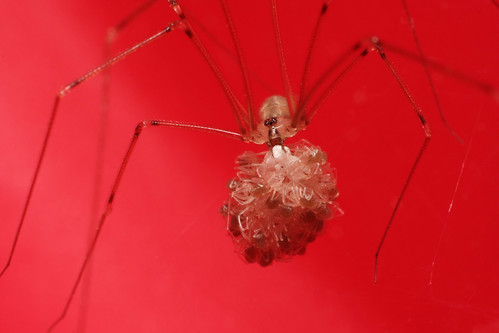There are many predators in the urban environment, but most are generalist consumers because they eat a wide variety of insects and can maintain themselves in an uncertain habitat. Of course, some of the most obvious to humans are the spiders, which are the maligned creatures I'd like to delve into for the next few blog entries.
I've had many encounters with cellar spiders (family Pholcidae) in my day; my own basement is probably some sort of utopia for them. These are the spindly, long-legged spiders you may find hiding in corners or windows. They spin irregular, wispy webs which they do not eat before leaving the way many other spiders do (neighboring cobweb spiders don't help the mess, either).
This is a female carrying her newly hatched babies. The red background is the bucket she was hiding in (Flickr).
Cellar spiders eat many annoying house pests such as gnats, flies, small moths, and mosquitoes. Their webs are not adhesive, but these spiders are quick to act and wrap up their prey when it gets lost in their irregular nets. The spiders' quick movements are also useful for another hunting techniques. Cellar spiders will go to other spider webs, tap the lines to imitate prey, and then attack when the owner comes to investigate. Pholcidae are also known for their vibrations when provoked.



Hi Cait! Do you mean to say they are misaligned, as in crooked... or maligned?
ReplyDeleteHa! I should have you edit my papers in the future.
ReplyDeleteGreat shot and looking forward to more info. Thanks, Cait!
ReplyDeleteAndy
Excellent service and very knowledgeable about plants. Brisbane Landscaper
ReplyDelete